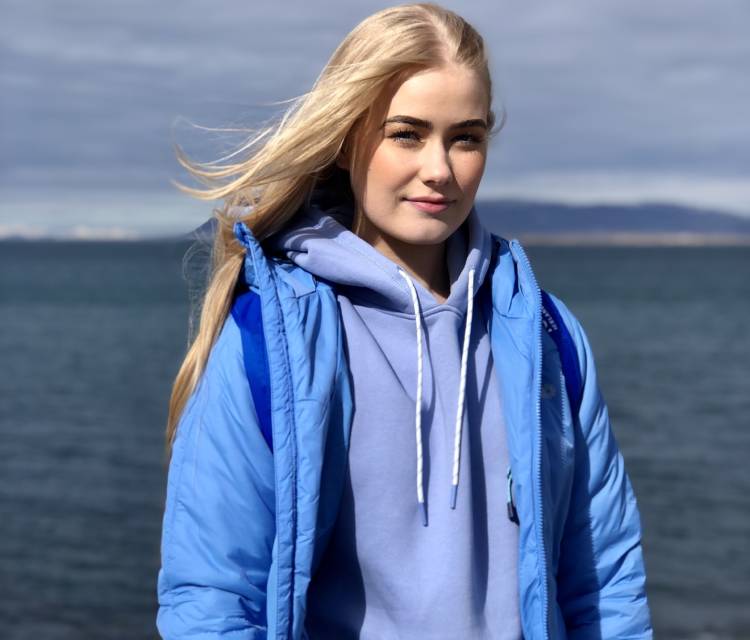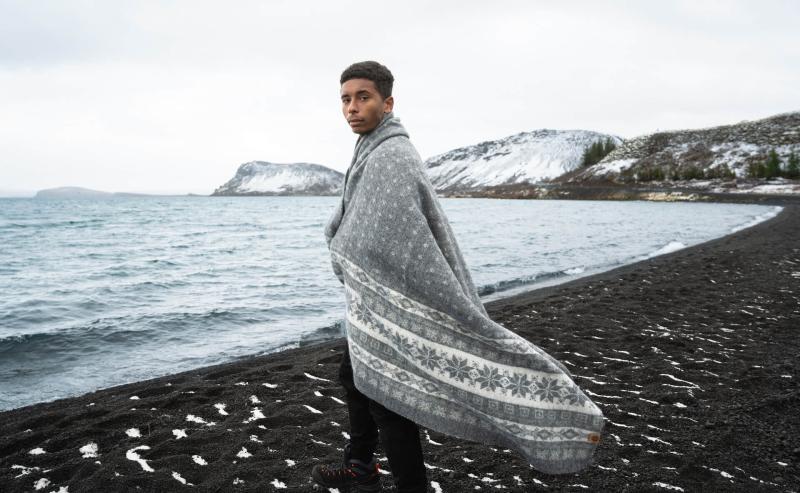Key Findings:
- The picturesque village of Vík í Mýrdal, Iceland lies nestled between the Mýrdalsjökull glacier and the southern Icelandic coast.
- In the village center, a storefront originally known as Víkurprjón Wool Factory was acquired by Icewear in 2012.
- Today, the building is a small mall that offers key amenities for tourists traveling along Iceland's southern coast.
- The mall now has an Icewear store and outlet, a supermarket, a café, a restaurant, and bathroom facilities.
Index:
- The Story of the Víkurprjón Wool Factory
- Vík Icewear’s Development: A Modern Shopping Experience in Vík
- Discovering Vík, South Iceland: A Gateway to Natural Wonders
- Reynisfjara Black Beach
- Reynisdrangar Sea Stacks
- Dyrhólaey Peninsula
- Mýrdalsjökull Glacier
- What to Pack for Your Visit to Southern Iceland: Icelandic Wool and More
- Everything to Know Ahead of Time About Vík í Myrdal
- Vík Demographics and Economy
- Vík Historical Development
- Reasons to Stay in Vík Overnight
The picturesque village of Vík í Mýrdal, Iceland lies nestled between the Mýrdalsjökull glacier and the southern Icelandic coast. And, in the center of town, the Vík Icewear store stands as proof of the tradition and transformation the village boasts.
Originally known as Víkurprjón Wool Factory, the large storefront and adjoining factory were acquired by Icewear, the wool and outdoor clothing manufacturer, in 2012. Since then, the building got its own Icewear store and several other amenities. It’s become a popular pitstop for tourists making their way across southern Iceland. Today, the small mall offers a glimpse into Iceland’s rich textile history as well as access to the full catalog of Icewear clothing, hiking equipment, souvenirs and more. The multifaceted shopping destination has drawn more people every year.
The Story of the Víkurprjón Wool Factory
Víkurprjón was a wool company in Vík whose expansive floor space included a shop and local wool product production. Víkurprjón means “Vík knitting” in Icelandic, and the storefront was originally filled with Icelandic yarn and Víkurprjón-made products, including Icelandic staples like traditional lopapeysa sweaters.
For the local community, the Víkurprjón Wool Factory was synonymous with the high-quality wool products made unique by the qualities of Icelandic wool. The factory also offered a constant vantage point into the intricate process of wool production that defines so much of Icelandic textile history, with its looms constantly in action.
In 2012, Icewear, the wool and outdoor clothing manufacturer, acquired Víkurprjón. This marked a new chapter in the store’s history, but the acquisition was a natural one with Icewear’s own record of wool product manufacturing. Icewear was, it seemed, the natural successor to the Víkurprjón legacy.
The Víkurprjón production arm remained in action for another seven years. By 2019, however, manufacturing was moved to consolidate production and work toward greater efficiency. This was due, in part, to the rising number of tourists each year. Products were flying off the shelves. Vík was perfectly positioned for tourists traveling through southern Iceland, and visitors to the country made up the bulk of buyers of the high-quality Icelandic wool goods.
After manufacturing was moved out of Víkurprjón, Icewear seamlessly integrated a more extensive range of its outdoor clothing and accessories into the store. The space was used to provide travelers and passers-by with a greater range of products than ever before, including a growing line of the high-quality woolen goods Víkurprjón was originally known for.
Vík Icewear’s Development: A Modern Shopping Experience in Vík
Since acquiring the Víkurprjón Wool Factory, Icewear has updated the building in several other ways, too. First, when manufacturing was moved out of Vík, the space became a 3,500-square-meter mall ready for more Icewear products. The growing needs of Vík’s increasing tourist traffic drove the additions that came after that, most of them in the summer of 2017. The mall now has:
- An Icewear outlet section on the second floor of the building
- A dedicated wool department in the Icewear store with traditional wool sweaters, blankets, and accessories
- A supermarket with essential groceries, toiletries, and other goods
- A bistro restaurant and a bakery café, both offering delicious meals for anyone who stops en route to the many nearby destinations
- Bathroom facilities for visitors spending time in the mall or just passing through
The mall’s setup caters to tourists while serving as a community hub for local shoppers. Vík was already a key stop on any southern Iceland excursion due to its location between famous sites. Now, with the Víkurprjón storefront developed into the Vík Icewear Mall, the new comforts and amenities complement extended visits while shoppers peruse Icewear’s wool products and souvenirs.
Discovering Vík, South Iceland: A Gateway to Natural Wonders
Vík í Mýrdal, often referred to as Vík, is a small and unassuming town that’s nonetheless an essential stop for anyone traveling or trekking across Iceland’s southern coast. The village is nuzzled between some of southern Iceland’s most breathtaking natural attractions, but many of those outdoor destinations require a “rest and regroup” in between. That’s how Vík became a favorite stopover destination.
Looking at a map, it’s easy to see why Vík is considered a central location between sites. Nearby natural attractions include:
- Reynisfjara Beach: Famous for its black sand and basalt columns, this beach is one of Iceland’s most iconic landscapes.
- Reynisdrangar Sea Stacks: These towering rock formations rise majestically from the ocean, steeped in local legend and folklore.
- Dyrhólaey Peninsula: A birdwatcher’s paradise, Dyrhólaey offers stunning views and the chance to see puffins during the summer months.
- Mýrdalsjökull Glacier: Explore the glacier that covers the Katla volcano, offering unique hiking and snowmobile adventures.
Your own southern Iceland adventure might point you east toward Jökulsárlón Glacier Lagoon or west to Reykjavík. Either way, Vík is more than a convenient pit stop. It’s also a memorable visit along the way that will provide you with good food, incredible Icelandic products, and a real look into life on the coast of the Land of Fire and Ice.
Vík is truly the center of an outdoor paradise, which is why the Icewear store has focused on the needs of hikers. Some passers-by trek through as part of their adventures on the Laugavegur trail, and they’re especially grateful to restock on equipment and personal items. Other visitors come after a long day trip from Reykjavík by bus, and still others travel through in their rental cars. The trip from the capital lasts at least 2 ½ hours, so Icewear has developed the space to meet self-care needs as well as those of hikers heading to or returning from their expeditions.
What to Pack for Your Visit to Southern Iceland: Icelandic Wool and More
Iceland’s weather is famously unpredictable, and each season presents its own challenges and opportunities.
Here’s a guide to what you should plan to bring on your trip to Vík and the surrounding region, depending on the season. (Your packing list will also depend on your activities, for example, if you’re going on extended hikes or scaling a glacier you’ll need more equipment.)
These are the basic “must-have” clothing items to pack for each time of year.
From late winter into early summer (March - May), consider the following your “must-have” items:
- Sturdy hiking boots or comfortable walking shoes (depending on your activities)
- Lightweight wool sweaters to use over base layers and under jackets
- Waterproof jacket and pants
- Wool socks and gloves
Through the longest days of summer (June-August), consider the following your “must-have” items:
- Sturdy hiking boots or comfortable walking shoes (depending on your activities)
- Sunglasses and sunscreen (remember that the longest summer days have 21 hours of sunlight)
- Breathable cotton shirts or lightweight wool (like Merino)
- Lightweight waterproof or fleece jacket for cooler evenings
- An eye mask to sleep better
When summer winds down and winter approaches (September-November), consider these your “must-have” items:
- Medium-weight wool sweaters, like Icewear lopapeysa knits
- A medium-weight coat, like a puffer jacket
- A wool at and accessories like scarves and gloves
- Waterproof boots and rain gear
- A thermos for longer excursions
During the coldest, darkest winter months (December-February), consider these your “must-have” items:
- Wool-insulated winter coat or parka
- Thermal base layers, preferably made of wool (due to natural moisture-wicking and anti-bacterial qualities)
- Wool mittens, wool socks, and other accessories like scarves or neck gaiters
- If you’re hiking, don’t forget the sturdiest boots and your crampons for icy conditions
Whatever season you visit in, the Vík Icewear store offers 1,500 square meters (15,145 square feet) of Icewear products that blend traditional Icelandic craftsmanship with modern outdoor gear. The store can be your perfect stop to fill up on necessary items or to prepare for your Icelandic adventure ahead of time.
Everything to Know Ahead of Time About Vík í Mýrdal
Vík í Mýrdal refers to two neighboring areas: Vík and Mýrdal. Together, they’re often called “Vík.” The small village sits right on Iceland’s southern coast, a little over 100 miles from the Icelandic capital, Reykjavik.
Vík has stayed relatively small in population, but its relevance—culturally and logistically—has grown over the years. It’s been recognized as one of the most picturesque destinations in the country, which contributes to its rising tourism. In town and close by, Vík offers breathtaking landscapes, rich cultural history, and a warm community atmosphere.
The current population of Vík is around 1,000 people.
Vík Demographics and Economy
Tourism is the main industry in Vík. Even among residents, foreign workers make up a majority, with 60% of residents born outside of Iceland.
Along with more tourists and a rising number of people moving to Vík, the area has had to develop more accommodations than ever before. New hotels and apartments are filled as soon as they’re leased, and the town is constantly taking steps to ensure that infrastructure development keeps up.
In addition to the tourism industry, Vík has a small-scale agricultural and finishing economy that contributes to local household income.
Vík’s Historical Development
The history of Vík is closely tied to its geographic location and natural resources. The village’s development began in earnest in the late 19th and early 20th centuries, with fishing and farming serving as the original livelihoods for most of the village’s residents.
The construction of the Reyniskirkja church in 1929 marked a significant moment in Vik’s history, establishing Vík as a more permanent settlement.
By the end of the 20th century, Iceland’s infrastructure was improving faster than ever in parallel with record-breaking levels of tourism. Vík started to emerge as a key destination on the southern border of the Ring Road, which is Iceland’s main highway that circles the island. The nearby and utterly stunning black sand beaches, dramatic cliffs, and the village’s proximity to the Mýrdalsjökull glacier attract more visitors every year. The village gradually transformed into a more tourism-centered community over the last 30 years.
Vík is not only a gateway to some of Iceland’s most famous natural attractions, it’s also a village that honors its history while embracing the growth brought by the steady stream of visitors.
Reasons to Stay in Vík Overnight
The Vík Icewear Mall is a key stop for most visitors to the southern coast, but the town itself is also a wonderful place to stay overnight between excursions. After visiting the Icewear store, be sure to stop by the Reyniskirkja Church in Vík’s center square. This charming wooden church, dating back to 1929, offers a glimpse into the village’s history and provides exquisite views of the surrounding landscape.
Other reasons to stay in this charming village include:
- Proximity to multiple attractions: There are multiple sites nearby you’ll want to see, so it makes sense to use Vík as a resting place between two days of breathtaking experiences.
- A way to avoid the crowds: By staying in Vík, you can visit nearby tourist spots early in the morning or late in the evening when crowds are smaller.
- If the season’s right, you can enjoy the Northern Lights: Vík's remote location with minimal light pollution makes it an ideal spot to view the Northern Lights during the winter months.
- Experience local culture: Spending the night in Vík allows you to engage more deeply with the local community, including visiting local restaurants and shops.
- Access to more photo ops: The unique landscapes around Vík—including its black sand beaches and dramatic cliffs—offer incredible photographic opportunities, especially during sunrise and sunset.
- A way to support local businesses: By staying in Vík, you contribute to the local economy, supporting small hotels, guesthouses, restaurants, and shops.
- Endure less travel fatigue: Staying overnight breaks up the long drive along the southern coast, reducing travel fatigue and making your journey more enjoyable and manageable.
- Experience unique accommodations: Vík offers a variety of unique and cozy accommodations, from charming guesthouses to modern hotels, providing a memorable stay in this picturesque village.
The Vík Icewear store stands as an example of how tradition and innovation can coexist. The Víkurprjón mall now offers a unique shopping experience that both honors the heritage of Icelandic wool and caters to the modern needs of today’s adventurers.
As you journey through the breathtaking landscapes of southern Iceland, make sure to stop by Vík Icewear and experience the rich history and welcoming hospitality of this symbolic village.









